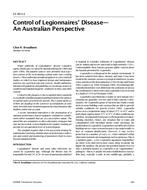Description
Major outbreaks of Legionnairesƒ disease (causative agent, Legionella spp.) occurred in Australia during the 1980s and early 1990s. The putative sources were primarily heat rejection systems of the recirculating cooling water type (cooling towers). These outbreaks prompted engineers to carry out field studies on which to base improved design and maintenance practices for such heat rejection systems. Health authorities introduced regulations and guidelines to encourage owners to establish and maintain hygienic conditions in these and other systems.
Central to this progress is the recognition that Legionella is essentially a biofilm organism and that it prefers the surfaces of warmer parts of systems for growth. This is particularly so if there are deadlegs in the system or accumulations of sediment. Biocidal water treatment approaches must therefore take biofilm control into account.
A recent Australian innovation is the preparation of a national performance-based regulatory standard to complement earlier standards that are of a prescriptive nature. The aim of this new standard is to allow alternative strategies that may not necessitate system shutdown for regular cleaning yet provide for an equivalent level of system hygiene. The standard requires that a risk assessment strategy be implemented involving identification of performance indicators and control and monitoring of parameters likely to move beyond stipulated limits.
Units: SI
Citation: Symposium, ASHRAE Transactions, vol. 105, pt. 2, Seattle 1999
Product Details
- Published:
- 1999
- Number of Pages:
- 12
- File Size:
- 1 file , 880 KB
- Product Code(s):
- D-7490




